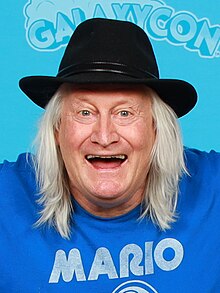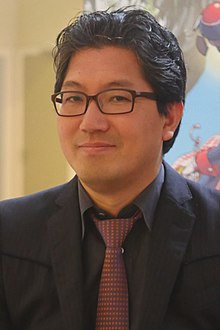Portal:Video games
The Video Games Portal

A video game or computer game is an electronic game that involves interaction with a user interface or input device (such as a joystick, controller, keyboard, or motion sensing device) to generate visual feedback from a display device, most commonly shown in a video format on a television set, computer monitor, flat-panel display or touchscreen on handheld devices, or a virtual reality headset. Most modern video games are audiovisual, with audio complement delivered through speakers or headphones, and sometimes also with other types of sensory feedback (e.g., haptic technology that provides tactile sensations). Some video games also allow microphone and webcam inputs for in-game chatting and livestreaming.
Video games are typically categorized according to their hardware platform, which traditionally includes arcade video games, console games, and computer (PC) games; the latter also encompasses LAN games, online games, and browser games. More recently, the video game industry has expanded onto mobile gaming through mobile devices (such as smartphones and tablet computers), virtual and augmented reality systems, and remote cloud gaming. Video games are also classified into a wide range of genres based on their style of gameplay and target audience. (Full article...)
Featured articles –
The game is played from a first-person perspective and allows the player to undertake a series of missions in a variety of ways, with an emphasis on player choice. Missions can be completed through stealth, combat, or a combination of both. Exploring each level opens new paths and alternatives for accomplishing mission goals, and it is possible to complete all missions, eliminating all of Corvo's targets, in a non-lethal manner. The story and missions are changed in response to the player's violent actions or lack thereof. Magical abilities and equipment are designed to be combined to create new and varied effects.
During its two and a half years in production, several versions of Dishonored were developed. Before the creation of Dunwall—inspired by late nineteenth-century London and Edinburgh—the game was set to take place in medieval Japan and seventeenth-century London. During development, test players discovered methods of exploiting the available powers and abilities to achieve unexpected outcomes; instead of restricting these techniques, the designers attempted to redesign levels to accommodate them. Dishonored's music score was produced by composer Daniel Licht to represent London in the nineteenth century. (Full article...)
X-treme was conceived as a side-scrolling platform game for the Sega Genesis to succeed Sonic & Knuckles (1994). Development shifted to the 32X and then the Saturn and Windows, and the game was redesigned as a 3D platform game for the 1996 holiday season. The plan was disrupted by company politics, an unfavorable visit by Japanese Sega executives, and obstacles with the game engines planned for use, including one from Sonic Team for Nights into Dreams (1996). Amid increasing pressure and declining morale, designer Chris Senn and programmer Chris Coffin became ill, prompting producer Mike Wallis to cancel the game. A film tie-in with Metro-Goldwyn-Mayer was also canceled.
In place of X-treme, Sega released a port of the Genesis game Sonic 3D Blast, but did not release an original 3D Sonic platform game until Sonic Adventure for the Dreamcast in 1998. The cancellation is considered an important factor in the Saturn's commercial failure, as it left the system with no original Sonic platform game. Elements similar to those in X-treme appeared in later games, such as Sonic Lost World (2013). (Full article...)
Presented in a first-person perspective, the game follows a robotic rabbit named "Robbit" as he searches for missing jet pods scattered by the game's astrophysicist antagonist character Baron Aloha. Robbit must explore each section of Crater Planet to retrieve all of the jet pods, stop Aloha and save the world from being destroyed. The game was designed as a technology demonstrator for the PlayStation console and was revealed in early 1994 under the provisional title of "Spring Man". Jumping Flash! utilizes much of the game engine used in Geograph Seal, an earlier game by Exact for the Sharp X68000 home computer.
Jumping Flash! has been described as an ancestor of, as well as an early showcase for, 3D graphics in console gaming. It was generally well received by critics, who praised its graphics and unique 3D platforming gameplay, but it was eventually overshadowed by later 3D platformers of the fifth console generation. Jumping Flash! spawned two sequels: Jumping Flash! 2 and Robbit Mon Dieu. It received positive reviews at the time of release, and made an appearance in Next Generation's "Top 100 Games of All Time" just one year after. The game was described as the third-most underrated video game of all time by Matt Casamassina of IGN in 2007. It holds the Guinness World Record as the "first platform video game in true 3D". (Full article...)
OneShot's gameplay and plot break the fourth wall and involve metafictional elements. Many puzzles involve interacting with the computer's operating system outside the game. Narratively, the player is separate from the protagonist, Niko. The latter arrives in a world without sunlight and aims to restore it by replacing its sun, a lightbulb, at the top of a tower.
OneShot was developed in RPG Maker XP. The game received positive reviews from critics, who praised the story, art, and metafictional aspects of gameplay, including the relationship between the player and Niko. In 2017, the game was nominated for the "PC Game of the Year" category at the Golden Joystick Awards. (Full article...)
In Islanders, players earn points by strategically placing buildings from their inventory onto a procedurally generated island. Earning points restocks the building inventory, eventually unlocking new types of buildings and the ability to move to a new island and continue the session. The session ends when no more points can be gained because no buildings are available or there is no space to place them. The overall goal of the game is to obtain the highest score possible in a single session.
Islanders was developed over seven months while the members of Grizzly Games were completing degrees in video game design at HTW Berlin. The developers were inspired by a mutual love of city-building games, and chose to embrace simplicity in designing Islanders because of the limitations of working with a small team. Employing procedural generation of new islands enabled them to keep the game's mechanics simple while still providing the player enough variety to make the game engaging for repeat sessions. (Full article...)
Did you know... -
- ... that the game designer of the video game Hades said that the characters were attractive "because Jen Zee"?
- ... that the video game Serious Sam: Tormental was originally inspired by Geometry Wars?
- ... that the video game Fursan al-Aqsa received an update that allows players to reenact the October 7 attacks on Israel?
- ... that the contrabass trombone has experienced a revival in film music and video game soundtracks?
- ... that MicroProse was formed to publish Hellcat Ace after Sid Meier boasted that he could design a better video game than Red Baron in a week?
- ... that the album series Jingle Cats spawned Jingle Dogs, Jingle Babies, and a Japanese video game in which "the object is to breed and care for cats, which begin to sing when they're done copulating"?
- ... that Justin Yu, the current Classic Tetris World Champion, is also a cellist in MIT's video game orchestra?
- ... that the name of the video game mod series Bomba Patch was inspired by éclairs?
- ... that approximately 85 percent of Manhattan was recreated for the 2008 video game The Incredible Hulk?
- ... that in the upcoming video game Marvel's Midnight Suns, players will be able to create their own superhero in the Marvel Universe?
- ... that the 1987 video game Oriental Hero was panned as "so incredibly bad it's almost worth a look"?
- ... that the video game Manor Lords was wishlisted more than three million times on Steam after its developer had estimated it would receive around 14,000?
Selected biography –
Selected image -
Recent video game-related events
- May 24, 2024 – Uvalde school shooting
- Families in Uvalde, Texas, U.S., file a lawsuit against Daniel Defense and Activision Blizzard for creating the DDM4 V7 gun and promoting the weapon through the game Call of Duty, respectively. They also sue Meta Platforms for owning Instagram, which was used by the gunman. (AP)
- April 16, 2024 – 2023–2024 video game industry layoffs
- American video game company Take-Two Interactive lays off 5% of its workforce. (Reuters)
- April 10, 2024 – 2023–2024 video game industry layoffs
- American video game company Epic Games announces that it will lay-off around 870 employees, roughly one-sixth of its workforce, due to slower growth than expected. (CBC via Yahoo! News)
Topics
Categories
Things you can do
In other Wikimedia projects
The following Wikimedia Foundation sister projects provide more on this subject:
-
Commons
Free media repository -
Wikibooks
Free textbooks and manuals -
Wikidata
Free knowledge base -
Wikinews
Free-content news -
Wikiquote
Collection of quotations -
Wikisource
Free-content library -
Wikiversity
Free learning tools -
Wiktionary
Dictionary and thesaurus
















































